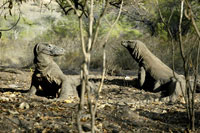The link between snakes and burrowing lizards is just now starting to become clear.
Click image to enlarge Though their body shape may give the impression that snakes are closely related to worm lizards, they are more closely related to monitor lizards such as the Komodo monitor. |
Genetic studies suggest that snakes are related to monitor lizards and iguanas, while their anatomy points to amphisbaenians ("worm lizards"), a group of burrowing lizards with snake-like bodies. Their exact relationship has been unresolved — until now.
The recent discovery by researchers from the University of Toronto (U of T) Mississauga and the Museum für Naturkunde Berlin, Germany, of a tiny, 47 million-year-old fossil of a lizard called Cryptolacerta hassiaca provides the first anatomical evidence that the body shapes of snakes and limbless lizards evolved independently.
"This fossil refutes the theory that snakes and other burrowing reptiles share a common ancestry and reveals that their body shapes evolved independently," said lead author Professor Johannes Müller of Humboldt-Universität, Berlin.
The fossil reveals that amphisbaenians are not closely related to snakes, but instead are related to lacertids, a group of limbed lizards from Europe, Africa and Asia. "This is the sort of study that shows the unique contributions of fossils in understanding evolutionary relationships," says Professor Robert Reisz from the U of T Mississauga, the senior author of the study. "It is particularly exciting to see that tiny fossil skeletons can answer some really important questions in vertebrate evolution".
Resolving the Confusion
The German research team, led by Müller and American graduate student Christy Hipsley, used X-ray computed tomography to reveal the detailed anatomy of the lizard's skull and compared the anatomy of Cryptolacerta and other lizards with DNA from living lizards and snakes to analyze relationships. Their results showed that Cryptolacerta shared a thickened, reinforced skull with worm lizards and that both were most closely related to lacertids, while snakes were related to monitor lizards such as the Komodo dragon.
Even though snakes and amphisbaeans separately evolved their elongate, limbless bodies, the discovery of Cryptolacerta reveals the early stages in the evolution of burrowing in lizards. By comparing Cryptolactera to living lizards with known lifestyles, co-author and U of T Mississauga paleontologist Jason Head determined that the animal likely inhabited leaf-litter environments and was an opportunistic burrower.
"Cryptolacerta shows us the early ecology of one of the most unique and specialized lizard groups, and also reveals the sequence of anatomical adaptations leading to amphisbaenians and their burrowing lifestyle," says Head. "Based on this discovery, it appears worm lizards evolved head first."
Reference: Johannes Müller, Christy A. Hipsley, Jason J. Head, Nikolay Kardjilov, André Hilger, Michael Wuttke, Robert R. Reisz. Eocene lizard from Germany reveals amphisbaenian origins. Nature, 2011; 473 (7347): 364. It can be found online here 10.1038/nature09919


